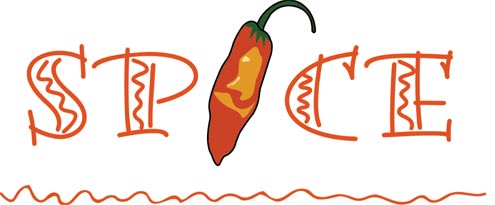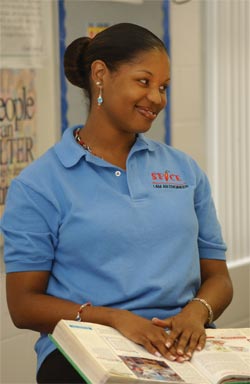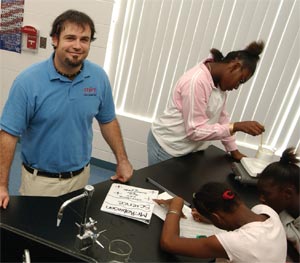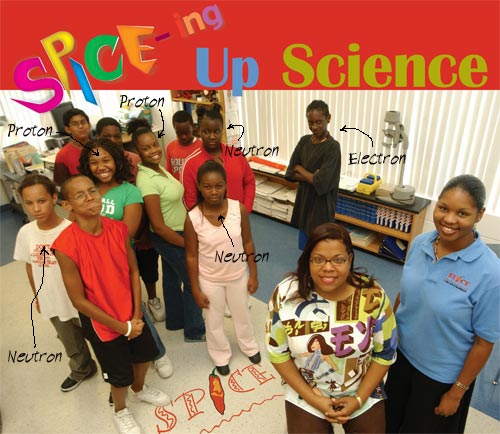|
|
|
 |
|---|
“It’s early in the morning, so everybody smells good,” says Stewart, a University of Florida graduate student, encouraging the students to move closer together.
As electrons walk around the nucleus looking sad, Stewart decides it’s time to form a different element. She tags a student-electron to leave the atom, and take a proton with him, lowering the group’s atomic number.
“That was my favorite lesson because everyone wanted to participate,” says Stewart, an environmental engineering master’s student with a background in chemistry. “When they took the exam, they scored highest on atomic theory. If you hear it, see it and do it, you remember it the best.”
 |
|---|
| Kyana Stewart |
“We focus on middle schools because studies have shown that early adolescents — especially girls — begin to lose interest in science, technology, engineering and mathematics,” says Doug Levey, the UF zoology professor who serves as the principal investigator on the SPICE grant. “We know that this is the time to keep kids interested.”
Stewart says the focus on minorities is what attracted her to the program.
“I was one of those students,” she says. “When I was in middle school, I was never really engaged in learning but I was fortunate to have a great science teacher and parents who were educators, who hooked me into science and engineering. A lot of these students don’t have those opportunities, so where are they supposed to go to get hooked?”
Donovan German, a zoology doctoral student with a marine science background, “hooks” eighth graders at Howard Bishop with a lesson on buoyancy called “Floating Fishes.”
During the lesson, German wanted to show that an object with negative buoyancy would sink, one with positive buoyancy would float on the surface, and one with neutral buoyancy would sort of hang out in the middle — like fish.
“The kids made fish out of plastic bottles and floated them in a tank to show neutral buoyancy and how different compounds (liquids and gasses) can be used to control buoyancy,” says German, whose enthusiasm for science is palpable, as he intently explains directions to individual lab groups. “A sub-theme was overfishing and what happens to fish as they are pulled from depth. It went over really well and I plan to do it again this year.”
Gordon Brown, an environmental engineering master’s student teaching at Lincoln Middle School, brought “Nature Bingo” to his sixth-grade students.
With colored pictures of animals, plants and insects on a laminated bingo card, students in groups of two ventured to the quad outside their classroom armed with grease pencils to find the trees, leaves, grasshoppers, spiders, dragon flies, and other flora and fauna depicted on their card.
“They couldn’t just mark them off, they had to show me or the other teacher what they found, and answer a question about it,” Brown says. “I’m trying to get the kids to ask me questions, instead of me asking them questions.”
First established at UF in 2003, graduate students and middle school teachers apply to the program annually, and a UF faculty advisory committee selects nine students and nine teachers each year to work together in the classroom. Graduate students receive a one-year $30,000 fellowship, plus tuition and fees, while the teachers receive a $3,325 stipend. Both receive $2,500 for supplies.
SPICE is part of NSF’s larger initiative to bring graduate students into K-12 classrooms.
“The GK-12 program will boost the content of elementary and secondary education and the quality of graduate and undergraduate education at the same time,” former NSF Director Rita Colwell said when the first grants were awarded in 1999. “This is a very practical approach: graduate and advanced undergraduate students will get direct classroom experience; young scientists will get involved in the educational process at an early stage in their careers; and the program gives recognition to teaching in a scientific career.”
The $1.7 million grant that supports SPICE is up for renewal this year.
“It’s a very time-intensive program,” says Angela Lindner, SPICE advisory committee co-chair and environmental engineering sciences assistant professor. “The fellows are paid a higher stipend, but the understanding is that it’s paying for that extra time in the classroom. It has been a caution to the beginning students to know what they’re getting into, and they all have agreed and embraced this.”
Fellows teach in middle schools two days a week, while keeping up with the regular course-load for their own classes.
“My first year I had to write out everything and predetermine what I was doing in the classroom,” Stewart says. “I was also working in the lab for my own classes and sometimes I’d go to teach with only three or four hours of sleep. This year is much easier because I know what to expect.”
As a first-semester fellow, Brown is taking the required “secondary science teaching methods” course on a pass-or-fail basis, and one class for his own major — the recommended first-semester schedule.
Fellows are also available for mentoring after school, and often put in more hours than they’re responsible for because, as Stewart says, they get attached to the kids.
“The energy that the fellows give is infectious,” Lindner says. “You’ll fall in love with seventh-grade teachers.”
Despite the burst of young energy, science lessons don’t always run smoothly. Getting students to read and follow directions is a challenge, particularly in an eighth-grade class with some students who read at a third-grade level. But the underlying factor to keeping kids’ attention (particularly in the beginning of the year) is the senior teacher who welcomes each fellow into his or her classroom.
“You have the full support of the administration and teacher,” Brown says. “We’re considered a co-teacher and the kids understand that kind of relationship.”
Towanda Luckie, who has taught science at Howard Bishop since 1989, has shared her classroom with Kyana Stewart for the past two years.
“I love the program,” says Luckie. “As a young African American female in the science field, Kyana serves as a role model for the kids, especially females, who mostly are minorities. And she’s young so she can relate to them better than I can. There’s a different type of relationship there, and extra help in the classroom is something every teacher would love to have.”
Stewart is equally praising of Luckie.
“She is a life-saver,” Stewart says. “If I want to do a lesson that I only have pieces of, she’ll fill in those gaps for me. It’s really a team effort, and in the classroom she treats me like a peer.”
German has a similar opinion of his teaching partner, Doris Raven.
“Doris is a really unique teacher in that she has a very strong motherly presence in the classroom, but she’s also very stern and doesn’t tolerate any crap,” he says. “A lot of these kids don’t have a lot of structure at home and she gives them that. Her knowledge of science is also amazing.”
As part of SPICE’s goal to introduce students to science and technology, middle school science teachers reap additional benefits for their students.
Luckie purchased four computers, a scanner, printer and digital cameras for her classroom this year through her SPICE grant. Students have gone on field trips to Camp Kulaqua in High Springs, the Florida Museum of Natural History at UF, Paynes Prairie State Preserve and the Sensational Science fair at UF.
“The students love when the college kids come in. They always ask, ‘Where is Miss Stewart,’” Luckie says. “I have to remind them she only comes once a week.”
 |
|---|
| Donovan German |
“He makes the science really interesting,” she says. Her favorite activity so far? Goo-yuck: a mixture of cornstarch, water and food coloring, which takes on different states of matter. Students determine the difference between a solid and liquid.
“They really respond to that one because it’s gooey, messy and disgusting,” German says.
Although time-consuming, fellows find their roles in the public school system has invaluable rewards.
“The feel-good factor is what I like the most,” German says. “I always want to be active in the community and this gives me a chance to meld my career with that, especially in east Gainesville.”
Stewart, who plans to teach after getting her master’s degree, also speaks highly of her experience as a SPICE fellow.
“It’s easy for me to create a bond with them because they see me and think, ‘Wait a minute, I could be her a few years down the line,’” she says. “It puts a lot of responsibility on me, but I love it because it’s a great opportunity to positively influence people.”
Doug Levey
Professor, Department of Zoology
(352) 392-9169
dlevey@zoo.ufl.edu
Angela Lindner
Assistant Professor, Department of Environmental Engineering Sciences
(352) 846-3033
alind@eng.ufl.edu
